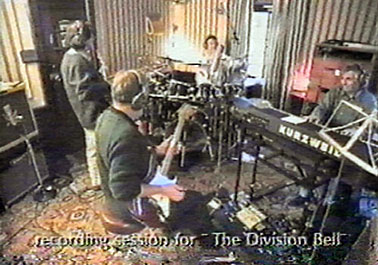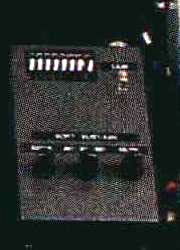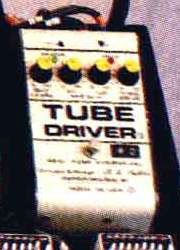|
Play these strings until my fingers are raw The magic behind Gilmour's Floyd came with a mix of old and new by Richard Mahon In this column, I'll be examining Pink Floyd guitarist David Gilmour's gear and playing techniques from a musicians point of view. Please feel free to e-mail me with questions and ideas for future articles at RichM66@Compuserve.com if you feel you have an idea that readers of Spare Bricks might find of interest. Past articles are posted at http://members.nbci.com/RichM66/sbarchive.htm David Gilmour's live setup for the two most recent Pink Floyd tours (1987-89 and 1994) have been covered in depth on many occasions. For this issue I will be going over equipment used in the recording studio for the two albums that followed the departure of Roger Waters. Sessions for A Momentary Lapse Of Reason The majority of A Momentary Lapse Of Reason was recorded with a Steinberger. Gilmour used the small-bodied guitar with a three single coil Strat pickup arrangement and a Trans-Trem. The guitar signal was split by a stereo volume pedal into two delay pedals. The volume pedal also ran between the pre-amp and power amp of the first feed--into a Gallien-Krueger 250ML amplifier. The second feed was sent to a Boss HM-2 Heavy Metal pedal into a Boss GE-7 graphic equalizer then into a Fender Super Champ amplifier. The main guitar track of "Sorrow" was recorded this way. This was the basic setup for most of the album. "Learning To Fly" - The guitar solos were recorded with a Fender Stratocaster. "Yet Another Movie" - A Boss CS-2 Compression/Sustainer, an MXR delay pedal and a Boss CE-2 Chorus pedal were used. A Big Muff was used during the guitar solo. "Round And Around" - Gilmour's 1959 Gold Top Les Paul was used and run through a tube amp simulator for the lead lines. "A New Machine part 1 and part 2" - A Vocoder with a Noise Gate was used. The noise gate was a modification of the Vocoder. This was used in place of a studio noise gate added in the chain. "Sorrow" - The intro was a Steinberger plugged into a Big Muff then a Fender Concert amp. Gilmour took the tapes and ran the intro through a loudspeaker setup at the Los Angeles Sports Arena. Gilmour also used a 1957 Re-issue Fender Stratocaster with a maple fretboard, EMG-SA active single-coil pickups and the EMG EXG tone control for boosting the highs & lows and the SPC to boost mid-range tones. Nick Mason used a Ludwig Drum kit and Simmons electronic drums. Rick Wright used a piano, a Kurzweil keyboard, a Hammond Organ and a Roland JX-10.
Sessions for The Division Bell Gilmour used a 1957 Re-issue Candy Apple Red Fender Stratocaster with a maple fretboard, EMG-SA active single-coil pickups and the EMG EXG tone control for boosting the highs & lows and the SPC to boost mid-range tones for the majority of the album sessions. He also used two 1970s 50 watt Hiwatt amplifiers, two Fender Bassman amplifiers and a Maestro Rover revolving speaker. Gilmour's main distortion pedal was a Pete Cornish soft sustain. This was a modified MXR unit custom made for him by Pete Cornish. A Chandler Tube Driver (the MK 1 version, which is superior to the models that followed) was also used extensively. Other effects included a Big Muff and Maestro Rover units.
"Poles Apart" - Gilmour's 1959 Gold Top Les Paul was used for the guitar solo. "Marooned" - Gilmour used his red Strat. A Digitech Whammy II pedal was featured. This pedal allowed Gilmour to play a note and have it sound one octave higher when the pedal was pushed to the floor. The high note at 0:50 into the song was achieved by hitting one of the thin strings above the nut, then shaking the vibrato bar. Mason played a Drum Workshop drum kit with black Ludwig tom toms and Wright played a Kurzweil, which was set up to sound like a piano. Wright's part was later copied on a real piano at Metropolis Studios in London. "A Great Day For Freedom" - The 1959 Gold Top Les Paul was used for the guitar solo. It sounds like a phase effect was used but it was, in fact, a bit of studio trickery during the mix. The album was recorded on two separate (24 & 16 track) machines. The guitar solo was duplicated from one machine to the other, then both sources were mixed together. As one machine was 'chasing' the other by means of a time code the synchronization was off, creating a 'phase' effect. "Wearing The Inside Out" - Gilmour used his red Strat for the guitar solo. He also used the Digitech Whammy II pedal. It can be heard at 2:32 into the song. "Take It Back" - During sessions for the album, as an experiment, Gilmour used an E-bow on a Gibson J-200 acoustic guitar. It was processed through a Zoom effects box then plugged directly into the studio console. The original plan was to record a duet between the E-bow guitar setup and a piano but that idea never came to fruition. Jon Carin sampled the E-bow section and used part of it as the introduction to this song and another section as the opening to "Keep Talking." "Coming Back To Life" - The electric guitar parts of this song were recorded on Gilmour's red Strat with the pickup switch in the 4th position (using the middle and bridge pickups together in phase.) "Keep Talking" - A few seconds from Carin's E-bow sample is used during the intro and a Heil Talk Box was used towards the end of the song.
Richard Mahon is a staff writer for Spare Bricks.
|



